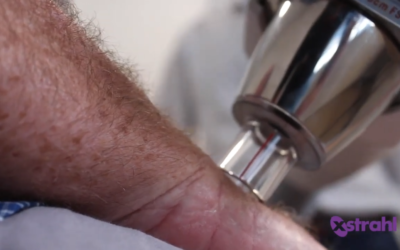
One common question dermatologists often ask about incorporating radiation therapy into their practice is “How much involvement do I need from a radiation oncologist?”
Regulations concerning physician supervision, reimbursement, and radiation shielding can vary quite significantly from state to state so dermatologists typically have multiple options when establishing their surface radiation therapy program. Although it is not directed by law in many instances, many dermatologists choose a collaborative approach with a radiation oncologist, similar to the structure that is in place at Precision Dermatology.
Precision Dermatology is a comprehensive dermatology service provider in Kerrville, Texas. The practice offers both medical dermatology and surgical dermatology procedures to treat a variety of conditions, including skin cancer. Dr. Robert Ebeling, a regional radiation oncologist, works closely together with Dr. Matthew Lambiase, the lead dermatologist, to support skin cancer patients and some benign disease patients with electronic brachytherapy and superficial radiation therapy using the RADiant dual modality system.
Years ago, Dr. Ebeling became aware of a surface radiation therapy when he saw RADiant at the American Society for Radiation Oncology (ASTRO) annual meeting. He was intrigued by RADiant’s compact design, which enabled radiation to be delivered through a smaller, mobile treatment unit, and thus bring the benefits of radiation to more patients.
Dr. Ebeling recognized the value to patients of being able to provide radiation therapy in an office-based dermatology setting, and the partnership with Dr. Lambiase was born. Dr. Lambiase subsequently became the first dermatologist to offer RADiant in the state of Texas and now many more dermatologists in Texas use the RADiant system to deliver radiation therapy treatments right in their offices.
Radiation therapy is not intended to completely replace surgery for dermatologists; radiation therapy allows dermatologists to provide patients with another treatment option that can improve both patient care and convenience in some cases where patients are not good surgical candidates. “It is a much less cumbersome and more efficient way to deliver radiation to patients who previously would not have had that as an option,” Dr. Ebeling explained.
Regarding patient selection criteria, Dr. Ebeling further described: “In general, we think patients better suited for radiation therapy are the ones that are either elderly and they wouldn’t recover from surgery well or, say, the lesion is very visible – it’s on the face or it’s somewhere where there may be compromised blood flow, say on the tip of your nose, which is a common place to have cancer. It is, however, a-not-so-great place for healing.” Patients who have comorbidities, such as a heart condition, or may be on chronic blood thinners and can’t stop their medication may not be candidates for surgery either, he added.
With radiation therapy, there’s no cutting or stitches, so there’s very little scarring. “It’s more of an area of redness for a while during and just after the treatments, but that heals and fades back to normal,” said Dr. Ebeling. While treatment outcomes are similar for both surgery and radiation therapy, Drs. Ebeling and Lambiase have observed that radiation often leaves the patient with much more pleasing cosmetic outcome in many cases.
Although supervision requirements in Texas do not require Dr. Ebeling’s participation, the physician partnership works very well to streamline the radiation therapy workflow and Drs. Ebeling and Lambiase believe it strengthens the level of care they can provide to patients.
“Instead of having to refer to a radiation oncology center that may be 45 to 60 miles away here in South Central Texas, what we’ve done is we’ve made available another tool in the quiver for dermatologists to utilize against skin cancer in their office,” often with fewer trips than would be required in a traditional radiation oncology clinic. Having a radiation therapy option in the dermatologist’s office also offers a comfort factor; the patients already know the doctor. They don’t have to see a new doctor and staff or have an additional consultation. Typically, the dermatologist’s office where they receive their treatment is much closer than a radiation therapy center as well.
This collaboration also benefits the dermatologists by improving their workflow and freeing up their time. Dermatologists, like Dr. Lambiase, can spend that saved time on surgery for patients whom it’s the better treatment option and let the radiation oncologist handle patients who are better candidates for radiation therapy.
While the word “radiation” often has negative connotations, when it comes to skin cancer treatments, it can be a pain-free, non-surgical alternative that results in excellent outcomes. Dr. Ebeling commented, “most physicians consider radiation oncology a black box that they just send their patients to, they get beamed a couple times, and glow in the dark when they are done. I would tell them that’s not how it is – skin cancer treatment does not have to be dominated by radiation oncology or dermatology. There’s a lot of room for collaboration, when done correctly.”
Dr. Ebeling said the best thing about working with RADiant from Xstrahl is the also the collaborative spirit. “Xstrahl is one of those few companies that really is trying to bridge the gap of patient care and make radiation therapy more accessible to everyone. The collaboration that Xstrahl encourages between dermatologists and radiation oncologists definitely helps to advance patient care and gives clinicians and patients more choices to combat skin cancer.”






